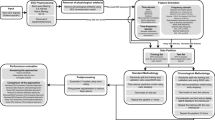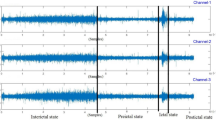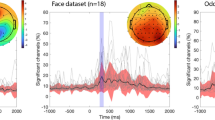Abstract
A recent neurophysical model of brain electrical activity is outlined and applied to EEG phenomena. It incorporates single-neuron physiology and the large-scale anatomy of corticocortical and corticothalamic pathways, including synaptic strengths, dendritic propagation, nonlinear firing responses, and axonal conduction. Small perturbations from steady states account for observed EEGs as functions of arousal. Evoked response potentials (ERPs), correlation, and coherence functions are also reproduced. Feedback via thalamic nuclei is critical in determining the forms of these quantities, the transition between sleep and waking, and stability against seizures. Many disorders correspond to significant changes in EEGs, which can potentially be quantified in terms of the underlying physiology using this theory. In the nonlinear regime, limit cycles are often seen, including a regime in which they have the characteristic petit mal 3 Hz spike-and-wave form.
Similar content being viewed by others
Log in or create a free account to read this content
Gain free access to this article, as well as selected content from this journal and more on nature.com
or
References
Babloyantz A, Destexhe A (1986). Low-dimensional chaos in an instance of epilepsy. Proc Nat Acad Sci USA 83: 3513–3517.
Freeman WJ (1975). Mass Action in the Nervous System. Academic: New York.
Jirsa VK, Haken H (1996). Field theory of electromagnetic brain activity. Phys Rev Lett 77: 960–963.
Lopes da Silva FH, Hoeks A, Smits H, Zetterberg LH (1974). Model of brain rhythmic activity. The alpha rhythm of the thalamus. Kybernetik 15: 27–37.
Niedermeyer E, Lopes da Silva FH (1999). Electroencephalography: Basic Principles, Clinical Applications, and Related Fields, 4th edn. Williams & Wilkins: Baltimore, MD.
Nunez PL (1974). Wave-like properties of the alpha rhythm. IEEE Trans Biomed Eng 21: 473–482.
Nunez PL (1995). Neocortical Dynamics and Human EEG Rhythms. Oxford University Press: Oxford.
Nunez PL, Silberstein RB, Shi Z, Carpenter MR, Srinivasan R, Tucker DM (1999). EEG coherence II. Experimental comparisons of multiple measures. Clin Neurophysiol 110: 469–486.
Rennie CJ, Robinson PA, Wright JJ (2002). Unified neurophysical model of EEG spectra and evoked potentials. Biol Cybernet 86: 457–471.
Robinson PA (2003). Neurophysical theory of coherence and correlations of electroencephalographic signals. J Theor Biol, in press.
Robinson PA, Rennie CJ, Rowe DL (2002). Dynamics of large-scale brain activity in normal arousal states and epileptic seizures. Phys Rev E 65, 041924, 1–13.
Robinson PA, Rennie CJ, Wright JJ (1997). Propagation and stability of waves of electrical activity in the cortex. Phys Rev E 56: 826–840.
Robinson PA, Rennie CJ, Wright JJ, Bahramali H, Gordon E, Rowe DL (2001). Prediction of electroencephalographic spectra from neurophysiology. Phys Rev E 63: 021903(1–18).
Robinson PA, Whitehouse RW, Rennie CJ (2003). Nonuniform corticothalamic continuum model of EEG spectra with application to split-alpha peaks. Phys Rev E, submitted.
Shaw GR (1991). Spherical Harmonic Analysis of the EEG, Ph.D. thesis, University of Alberta, Alberta, Canada.
Steriade M, Gloor P, Llinas RR, Lopes da Silva FH, Mesulam M-M (1990). Basic mechanisms of cerebral rhythmic activities. Electroencephalogr Clin Neurophysiol 76: 481–508.
Wilson HR, Cowan JD (1973). A mathematical theory of the functional dynamics of cortical and thalamic nervous tissue. Kybernetik 13: 55–80.
Wright JJ, Liley DTJ (1996). Dynamics of the brain at global and microscopic scales: neural networks and the EEG. Behav Brain Sci 19: 285–309.
Acknowledgements
This work was supported by the University of Sydney's Sesqui Grant Scheme and the Denison Bequest.
Author information
Authors and Affiliations
Corresponding author
Rights and permissions
About this article
Cite this article
Robinson, P., Rennie, C., Rowe, D. et al. Neurophysical Modeling of Brain Dynamics. Neuropsychopharmacol 28 (Suppl 1), S74–S79 (2003). https://doi.org/10.1038/sj.npp.1300143
Received:
Revised:
Accepted:
Published:
Issue date:
DOI: https://doi.org/10.1038/sj.npp.1300143
Keywords
This article is cited by
-
Robust closed-loop control of spike-and-wave discharges in a thalamocortical computational model of absence epilepsy
Scientific Reports (2019)
-
K-complexes, spindles, and ERPs as impulse responses: unification via neural field theory
Biological Cybernetics (2017)
-
Neural field model of seizure-like activity in isolated cortex
Journal of Computational Neuroscience (2017)
-
Firing responses of bursting neurons with delayed feedback
Journal of Computational Neuroscience (2011)
-
Neural Population Modes Capture Biologically Realistic Large Scale Network Dynamics
Bulletin of Mathematical Biology (2011)



